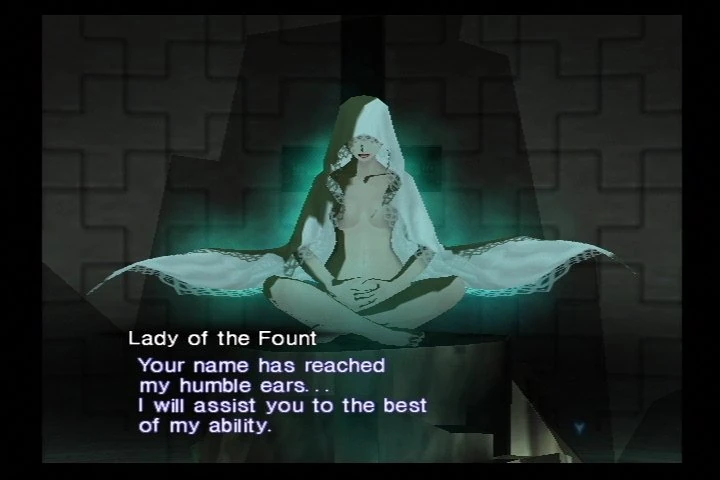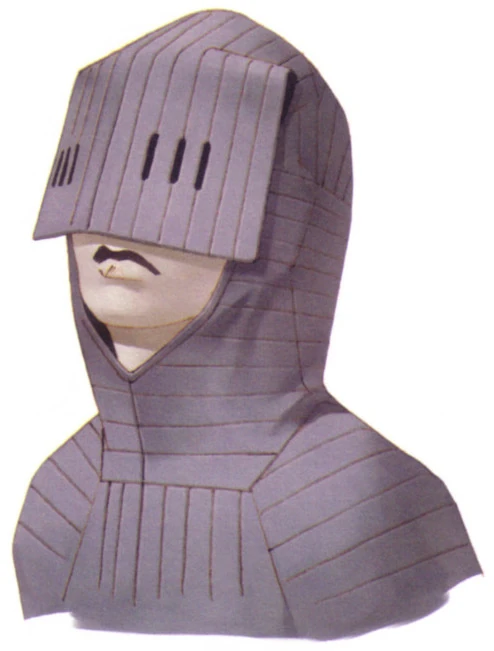SMTIIIN Step 2: Meeting The Manikins
Having played a not insignificant amount of this game, let's get into it again! While it hasn't swept me off my feet, I do believe that it's quite fun to examine - upcoming, we've got a pass through the Amala Network or two, a visit to Ginza, some stealing from Loki, and a pit stop at an underground town populated by pseudo-human beings, but first, a quick recap and a shopping trip in Shibuya.

We left off having killed the stingray-man Forneus and escaping the Shinjuku Medical Center, reaching Shibuya and meeting up with Chiaki, our pre-apocalypse friend. I want to get into the design of the stores while we're here in Shibuya's underground mall, because I kinda adore how they've all been made.
First up, the junk shop. It's an incredibly crowded little room, each one across the game world run by different demons - in this case, a Jack Frost. You Know What He Looks Like. But just in case, here's Hee-Ho, owner of the Shibuya Junk Shop:

These shops reinforce this idea that's present throughout the game, where the demons or human-likes that now populate the world LOVE to hoard treasures of the old world. Soon we'll meet the Manikins, beings that really look like humans, born from dead humans' strong emotions, some of whom collect large amounts of junk. One manikin operates a junk shop in an area we'll visit soon, and another gives us a fetch quest for a treasured 1000 yen bill. This comes across as something like an old instinct in these people, like they're grasping for the old world, for the humanity they were born from. Demons also hoard human objects, seen in every other junk shop, and with Loki, another demon we'll be meeting soon, who keeps a collection of old human objects. In this case, it feels like lower level demons - they are in the early game, after all - trying to accumulate power to climb the demonic hierarchy. Hee-ho's literally a merchant, what is money but power?
Ownership as a symbol of power has continued on, in the weak and the strong. Consumerism survived the apocalypse, and now it's OUR fuckin problem.
Next up, the healing fountains.

Lady of the Fount's real cute. You pay her money to live. Anyway,
Lastly, there's the Cathedral of Shadows, where you can go to fuse demons, and MAN is it fun to look at. In the center is an older man, wearing dark blue robes (honestly, he kinda looks like the cultural image of a rabbi?), stood in the center of three large cylinders. Frankly, this is a spiritual elder stood in a shrine made of a trio of nuclear power plant cooling towers, atop which you sacrifice the demons you convince to join you for greater power. It looks fuckin rad. I don't think finding a random jpeg would do it justice.

There's not much to say about the Amala network section after Shibuya. Hijiri sends you into the Amala through the Shibuya saving terminal, later called an Amala Drum, guiding you along, until you have a boss battle with six demons that voltron into one big version of themselves. Once you win, you make it to Ginza, which is yet another underground shopping mall, and get a bit of a break. This is, however, where I really first ran into the demon conversation system, which has good and bad parts, and neat thematic implications.
Firstly, sometimes demons run up to you at the start of a fight asking for an item. A stingray might prod you, saying something like "Hey Big Man, I speak in stereotypical "i'm dumb" talk, Can I Borrow Some Ibuprofen." and then, generally, if you give them a couple advil, they'll leave the fight early. I might've gotten a demon to join my party that way once, but I doubt it. The more important part of the Demon Conversation mechanic is that, if you kill every demon in a battle except for one, then you can talk to them, and maybe convince them to join your party. This is generally how you accumulate power; through new blood in your party, you get better spells, more chaff for the fusion smokestacks, and fresh demons tend to level faster, as demons level at a noticeably slower rate than the player character. Here's the neat part: a main aspect of the plot of the game seems to be focusing around a series of groups that are fighting to have their visions of the world realized, as the spherical Vortex World is a seeming transition point, allowing for a grand new world to be made. When you're convincing demons to join you, you are participating in that same mindset - leading these demons into battle to fight for the world you want to live in, shaping their skillsets along with yours to better affect change to reach your own political goals through violence, in a fairly quiet way. It is a genuinely really cool and subtle way of keeping the themes of the game present in as much of the moment to moment gameplay as possible.
However. Sometimes, as I Did, You Will Attempt To Convince A Particular Demon. They may be really useful for a bossfight, or they may just be very cute (see the Ame-No-Uzume I managed to fuse), or look rad as hell, but the way that the conversations work can then start to grate. You've got to give them what they want, or tell them no, a certain amount of times until they join you. This can absolutely destroy your wallet, as demons LOVE money, and you may have to give them a bunch of money many times for almost nothing as you try and find the right combinations of nos and yesses to get them to come with you. I think P5's simplified system works a whole lot better in terms of not slowing you down and not forcing grinding for money, as, y'know, you might also need to buy a bunch of healing items to survive the constant onslaught of demons.

